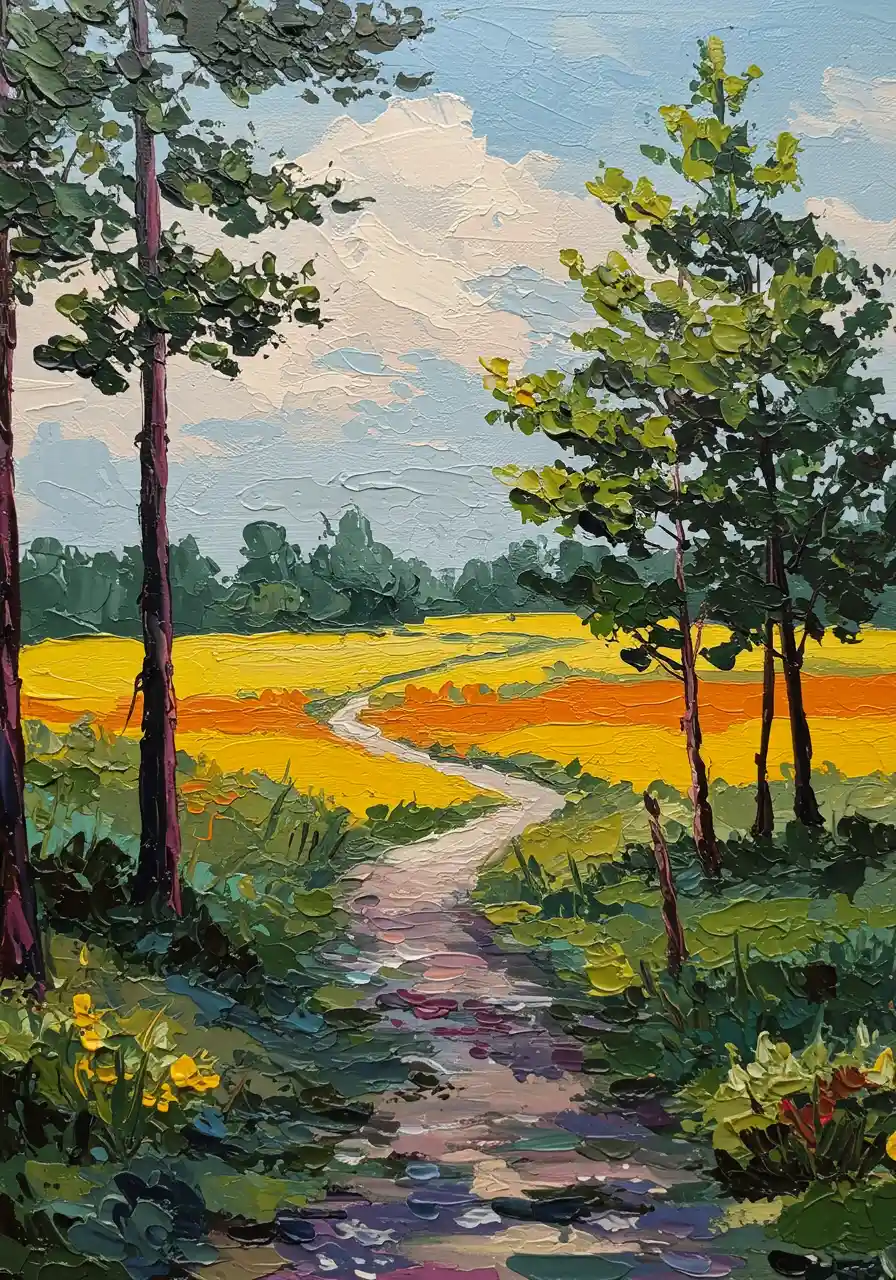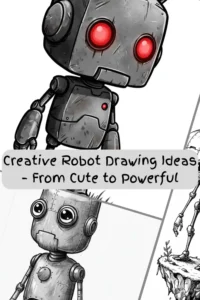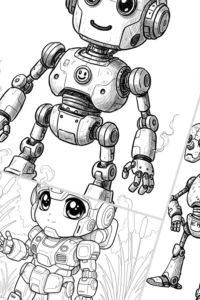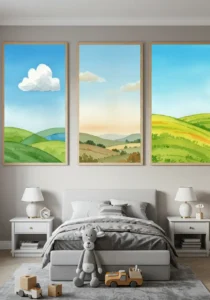Discover 16 creative and easy art ideas perfect for beginners who want to explore their artistic side. From simple sketches to colorful designs, these ideas will help spark your imagination and build your drawing confidence—one step at a time!
01 – The Beauty of Texture: A Captivating Impasto Landscape
This stunning impasto oil painting captures the fleeting beauty of either a sunrise or sunset, evoking a sense of tranquility and depth. The composition is defined by bold horizontal bands of color and striking silhouettes, creating a visually dynamic and textured scene.
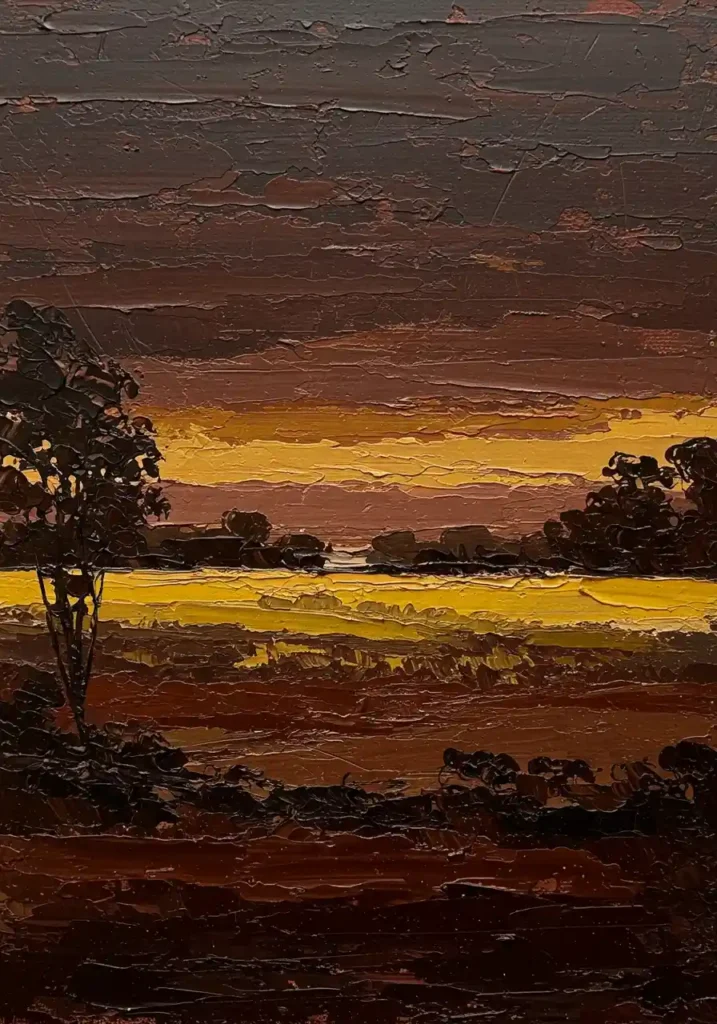
The foreground is dominated by dark, earthy tones—deep browns and near-black strokes—hinting at uneven ground or low vegetation. These textured layers provide a grounding contrast to the brighter elements of the painting.
In the middle ground, a radiant band of golden yellow and ochre steals the spotlight. This luminous strip could symbolize a glowing field or water reflecting the warm light of the sky. Along its edge, a line of silhouetted trees or structures stands in stark contrast, adding depth and intrigue to the scene.
The sky above is a masterpiece of layered hues, transitioning from vibrant orange near the horizon to darker, moody tones of reddish-brown and almost black. The thick application of paint through palette knife or brush strokes creates a tactile surface that invites viewers to explore its texture.
Warm yet somber, this painting masterfully blends glowing colors with deep shadows, making it a captivating representation of nature’s fleeting moments.
02 Artistic Ideas for Drawing: Exploring Abstract Textures and Vibrant Colors
If you’re looking to experiment with artistic ideas for drawing, abstract painting offers a world of inspiration. One captivating technique involves using vibrant colors and thick, textured applications of paint to create dynamic, visually exciting compositions.
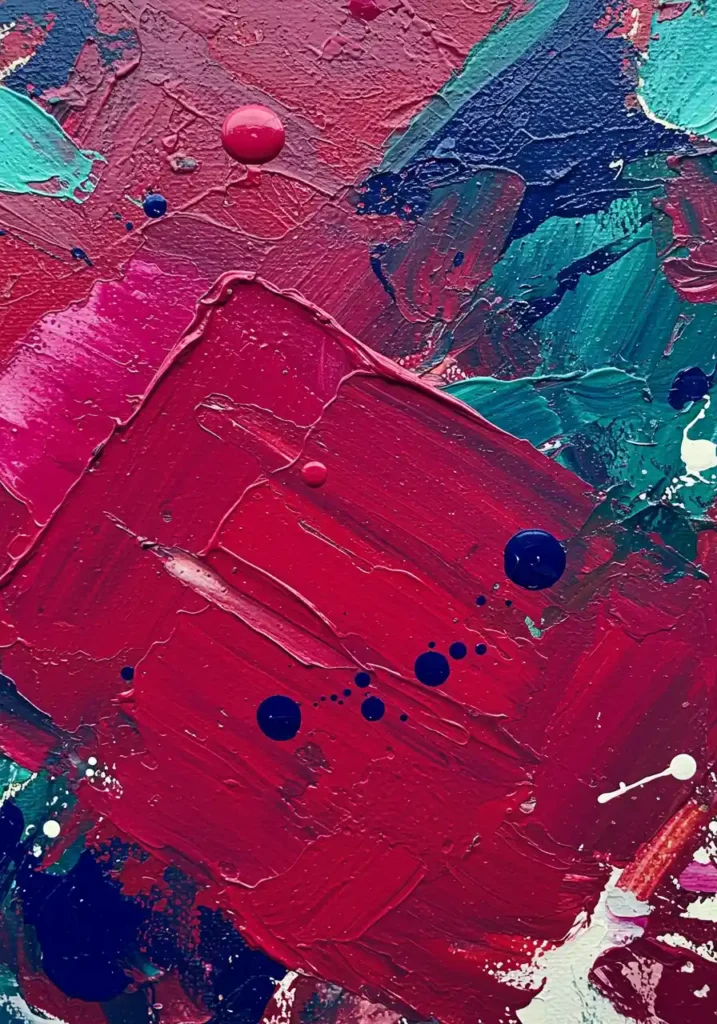
Imagine a close-up of an abstract painting where bright fuchsia, deep cobalt blue, and rich teal dominate the canvas. These colors, applied with broad, energetic strokes using a palette knife, create a textured surface that feels almost sculptural. The thick, impasto layers of paint overlap and interact, with fuchsia often taking center stage as the topmost layer in many sections.
Adding to the visual intrigue are glossy, spherical drops of paint—some in fuchsia and others in dark blue—strategically placed as accents. Smaller splatters and flecks of white and blue paint scattered across the surface contribute to a sense of spontaneity and movement.
This approach emphasizes the materiality of paint, encouraging artists to explore its tactile qualities. By juxtaposing bold colors and experimenting with texture, you can create artwork that radiates energy and excitement. Whether you’re a seasoned artist or just starting out, this technique is a fantastic way to push creative boundaries and bring your ideas to life.
03 Artistic Ideas for Drawing: A Still Life Masterpiece
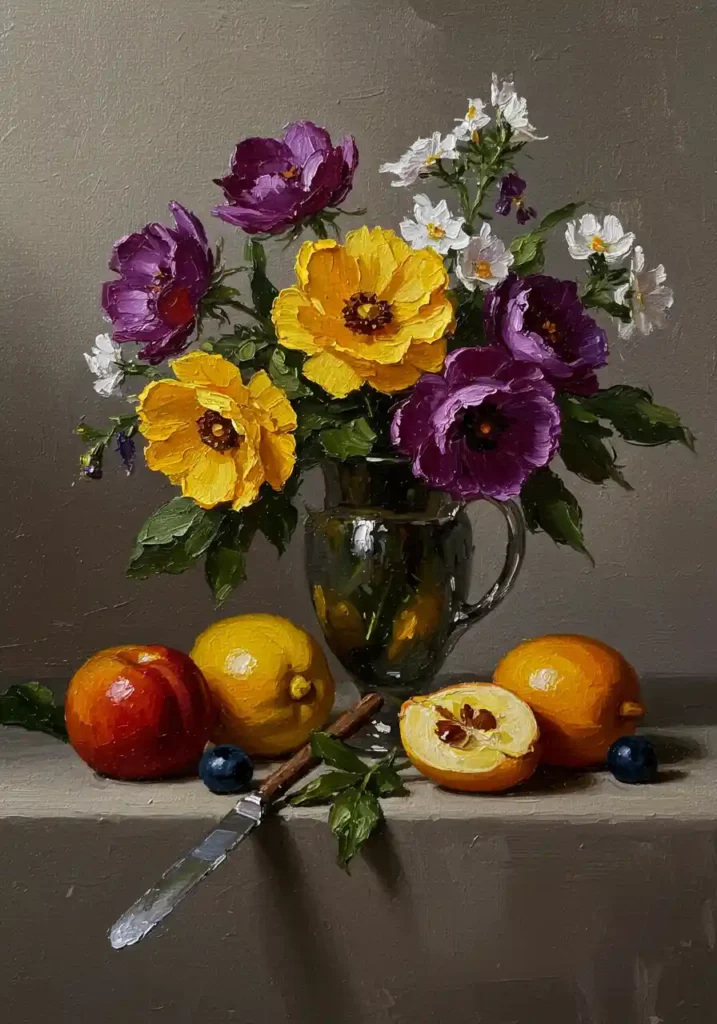
Exploring still life art offers endless opportunities to hone your drawing skills. One inspiring idea is to create a richly detailed still life scene that celebrates natural beauty and textures. Picture this: a vibrant bouquet of flowers in a clear glass pitcher, surrounded by an array of colorful fruits and a simple knife on a neutral tabletop.
The bouquet could feature bold yellow flowers with dark centers, complemented by deep magenta blooms and delicate white accents. The glass pitcher adds an element of transparency, revealing the stems within. Surrounding the arrangement, you could include a mix of fruits—perhaps a peach, a lemon, a halved quince with its intricate seeds exposed, and a few plums. Scatter some green leaves for added texture.
To elevate your drawing, focus on directional lighting that casts soft shadows and highlights. This creates depth and brings your composition to life. Pay attention to the reflective surfaces of the pitcher and knife, as well as the textured details of the petals and fruit.
This kind of still life not only challenges your technical skills but also allows you to capture the beauty of everyday objects in a timeless, artistic way.
04 Artistic Ideas for Drawing: Capturing the Beauty of a Vibrant Landscape
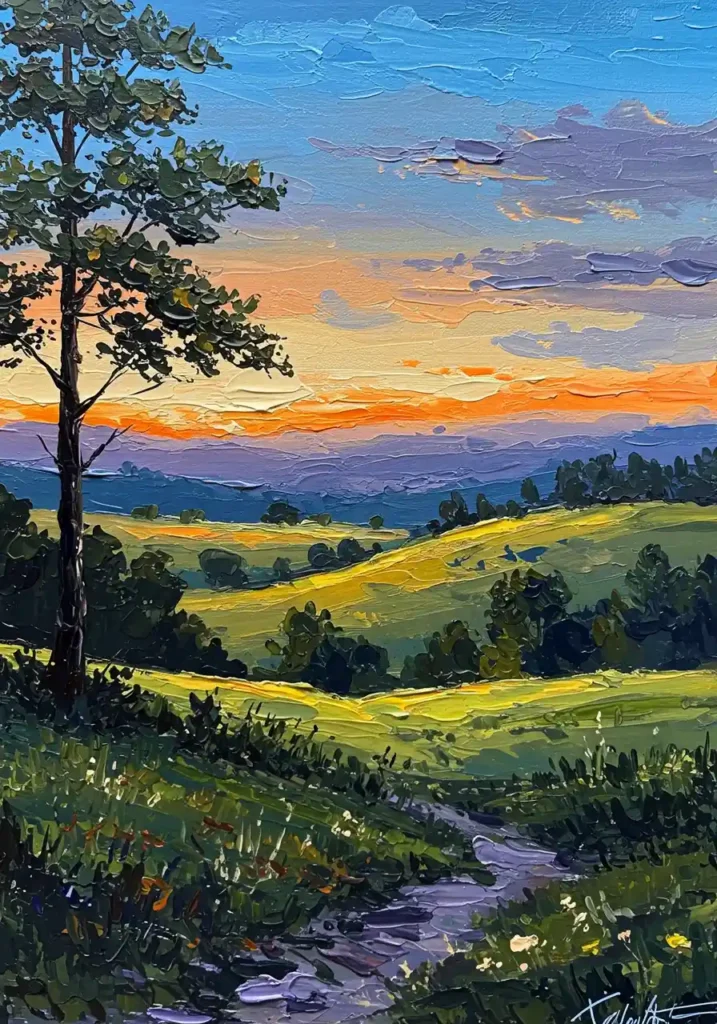
Exploring artistic ideas for drawing can lead to stunning creations, and one inspiring subject is a vibrant landscape. Imagine a countryside scene at sunrise or sunset, filled with expressive textures and bold colors. Using an impasto technique with a palette knife, artists can create thick, textured strokes that bring the painting to life.
In the foreground, a winding lavender-grey path invites the viewer into the scene, bordered by lush green grasses and pops of wildflowers in white, yellow, and orange. A tall tree with textured dark green foliage stands prominently, adding depth and dimension.
The middle ground reveals rolling hills bathed in warm sunlight, glowing with yellows and light greens, while darker tones of blue and green suggest shadows and contours. The distant horizon showcases hazy hills in deep blues and purples, creating a sense of tranquility.
Above it all, the sky steals the show with its fiery oranges and yellows near the horizon, transitioning into soft peaches and clear blues. Lavender clouds add drama and texture to the composition.
This artwork celebrates nature’s colors and textures, offering endless inspiration for artists to experiment with bold techniques and vivid palettes.
05 Exploring Artistic Ideas for Drawing: Embracing Texture and Color
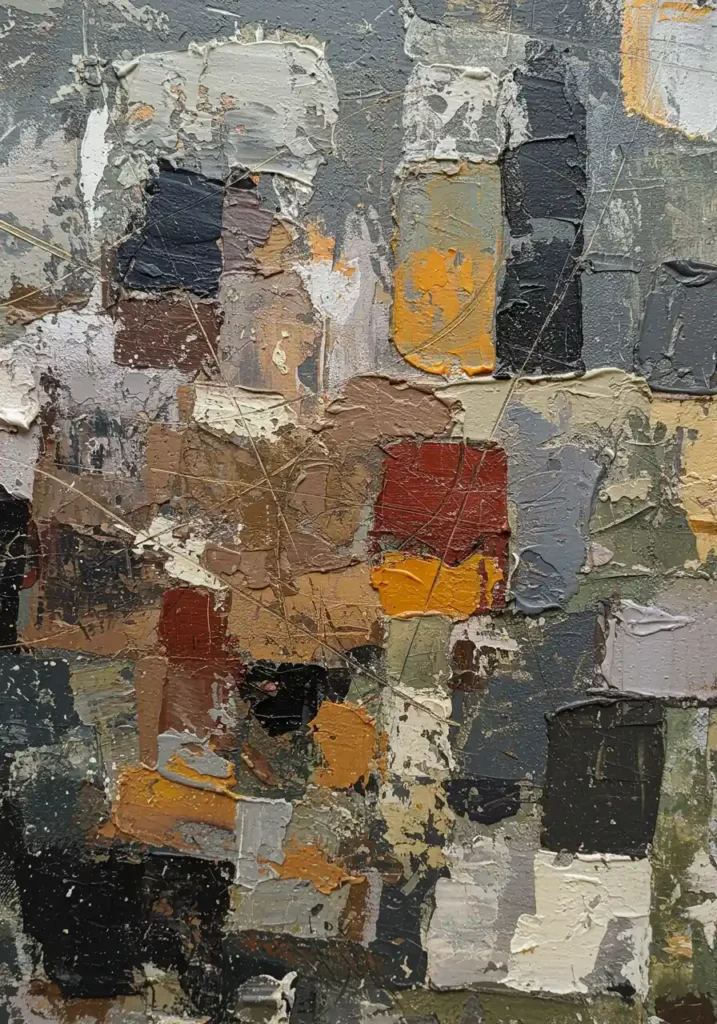
Artistic expression through drawing can take many forms, and one captivating approach is to explore the interplay of texture and color. A close-up photograph of an abstract painting can serve as a rich source of inspiration. Imagine a canvas where paint is applied thickly, perhaps with a palette knife, creating a textured, almost sculptural surface.
In this artistic vision, blocks of color form an irregular grid-like pattern. Earthy tones dominate the scene—shades of grey, brown, and black—interspersed with accents of ochre yellow, rusty orange, and cream. These colors not only add warmth but also contrast, enhancing the visual appeal.
The tactile nature of this artwork is further enriched by thin, incised lines scratched into the wet paint. Known as sgraffito, these lines crisscross the surface, weaving through and around the blocks of color. This technique adds depth, evoking a sense of aged or weathered surfaces reminiscent of old tiles or distressed walls.
By experimenting with these elements—texture, color, and incised lines—artists can create dynamic compositions that invite viewers to explore and engage with their work on multiple sensory levels.
06 Artistic Ideas for Drawing: Exploring a Vibrant Landscape
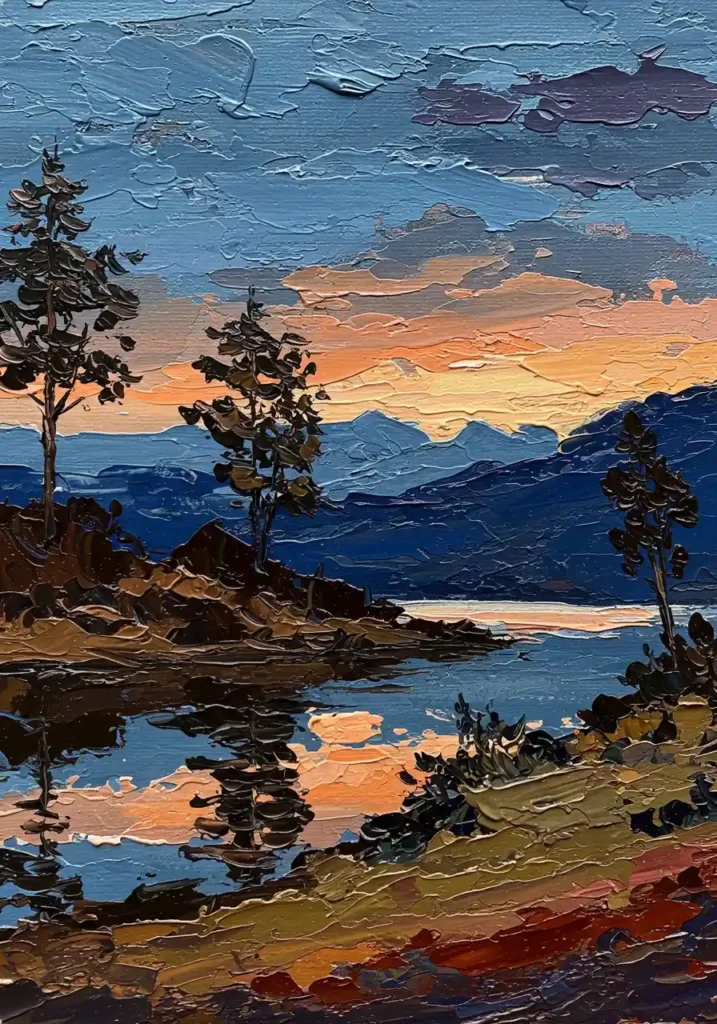
When it comes to artistic inspiration, landscapes offer endless possibilities for creativity and expression. One captivating idea is to create a textured, vibrant painting using a heavy impasto technique, often achieved with a palette knife. This method adds a sculptural dimension to your artwork, bringing it to life.
Imagine depicting a serene lake at sunrise or sunset. Begin with a dramatic sky, blending deep blues, lavender, and fiery hues of orange and yellow near the horizon to capture the sun’s glow. Silhouetted mountains in shades of blue and purple add depth and drama.
The water below mirrors the sky’s colors, streaked with orange and pale blue, while dark reflections of trees ripple on its surface. In the foreground, rugged details like rocky outcrops and earthy tones bring texture to the shoreline. Add slender, pine-like trees with sparse foliage for contrast, their reflections shimmering in the water.
This approach emphasizes bold contrasts—warm skies against cool waters—and uses thick paint application to create dynamic textures. The result? A striking, atmospheric piece that invites viewers to step into your world of color and light. Let your imagination flow and bring your artistic vision to life!
07 Artistic Ideas for Drawing: Exploring Abstract Expression
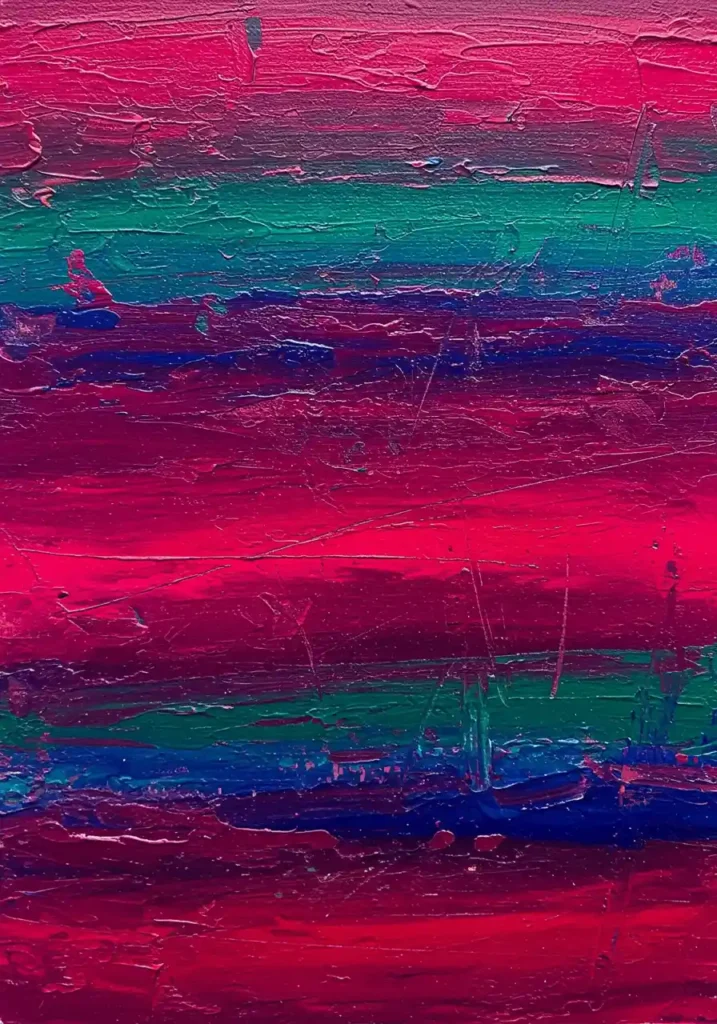
Abstract art offers endless opportunities for creative exploration, and one inspiring idea is to focus on vibrant colors and tactile textures. A close-up look at an abstract painting can reveal a world of artistic possibilities.
Imagine a composition dominated by broad horizontal bands of jewel-toned colors. Start with a vivid magenta or fuchsia pink as the centerpiece, layering it in thick impasto strokes to create depth and texture. Add a striking teal or emerald green band for contrast, its cool tones providing balance to the warmth of the pinks. Include thinner bands of deep cobalt or ultramarine blue for added dimension and dynamic transitions.
To enhance the texture, use a palette knife to apply paint thickly, creating ridges and troughs that follow the horizontal flow of the bands. Experiment with sgraffito techniques by scratching fine, light-colored lines into the wet paint. These incised lines, running diagonally or vertically, reveal underlying layers and add visual complexity.
The interplay of warm and cool tones, combined with rich textures, creates an energetic and captivating effect. Abstract art allows you to focus on color, form, and materiality, making it a perfect exercise for unleashing your creativity.
08 Exploring Dynamic Abstract Art: A Close-up on Textured Painting Techniques
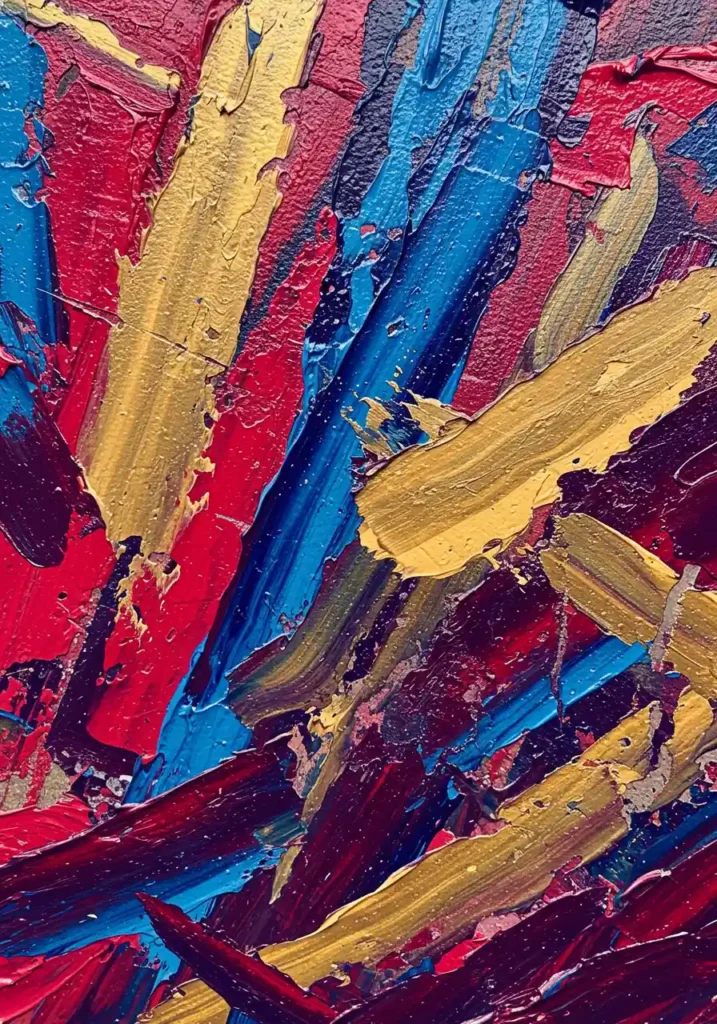
Abstract art offers a boundless playground for creativity, where colors and textures meld into a captivating visual experience. One compelling technique involves using a palette knife to apply paint in an impasto style, resulting in a highly energetic and textured surface.
Imagine a close-up of such a painting, where vibrant primary red, strong cerulean or cobalt blue, and lustrous metallic gold dominate the canvas. These bold colors are interwoven with deeper shades of maroon, darker blues, and hints of black or dark brown, creating depth in the recesses.
The paint is laid on thickly, in bold diagonal strokes that overlap and intersect. This method not only adds a tactile, sculptural quality to the artwork but also emphasizes movement and energy. The palette knife leaves ridges and drag marks, showcasing the forceful application of paint.
Metallic gold strokes often cut across or overlay the red and blue, offering striking contrasts in both color and sheen. Small flecks of paint contribute to the raw texture, making the piece visually stimulating. The interplay of these elements results in a dynamic composition that is both rich and expressive.
09 Artistic Ideas for Drawing: Exploring Abstract Watercolor Landscapes
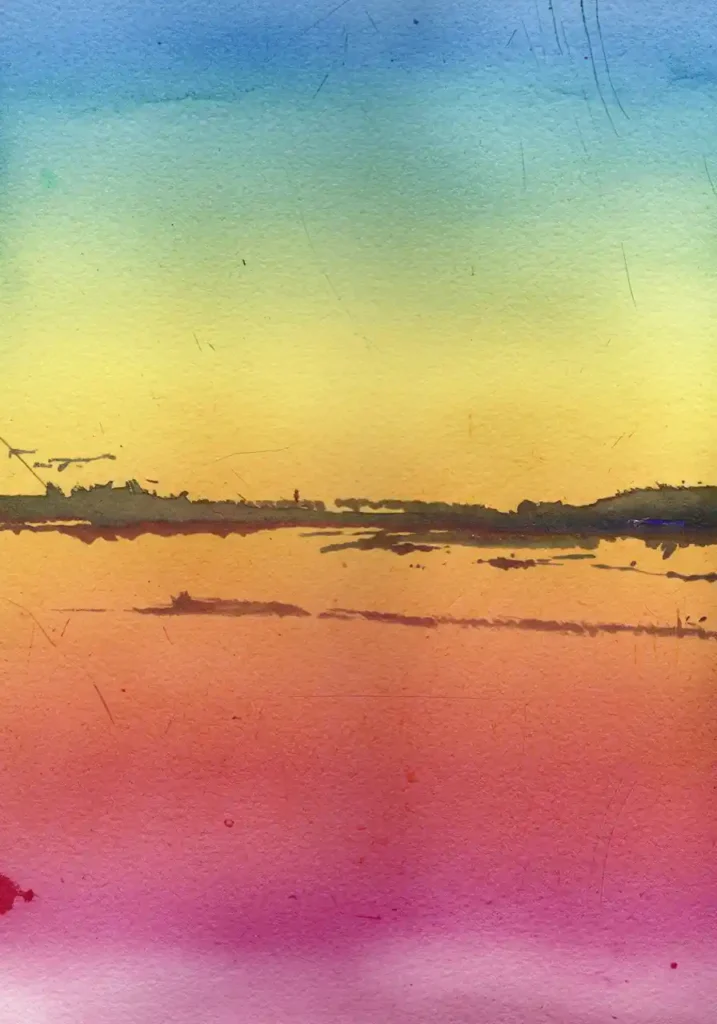
Creating abstract watercolor paintings is a fantastic way to explore your artistic side. One inspiring concept involves crafting a stylized landscape using broad, horizontal bands of blended colors on textured paper. This technique allows for a gradient effect that evokes a serene and dreamlike atmosphere.
Start by layering colors that transition smoothly. For example, the upper portion could fade from medium blue to cyan, then pale green, and finally into a bright yellow. To add depth, introduce bold, dark strokes across the middle, suggesting an abstract horizon line or distant landmass. These strokes can bleed slightly into the underlying washes for a painterly effect.
As you move toward the bottom, continue the gradient with warm tones—orange, reddish-orange, vibrant magenta, and pale pink—ending with the white of the paper. The texture of watercolor paper enhances the painting, with light scratches or incised lines adding subtle distress and detail.
This approach results in a serene yet slightly aged aesthetic, where vibrant color transitions contrast beautifully with stark dark strokes and delicate textures. Experimenting with these techniques can spark new ideas and elevate your artistic journey.
10 Exploring Dynamic Abstract Art: A Palette Knife Adventure
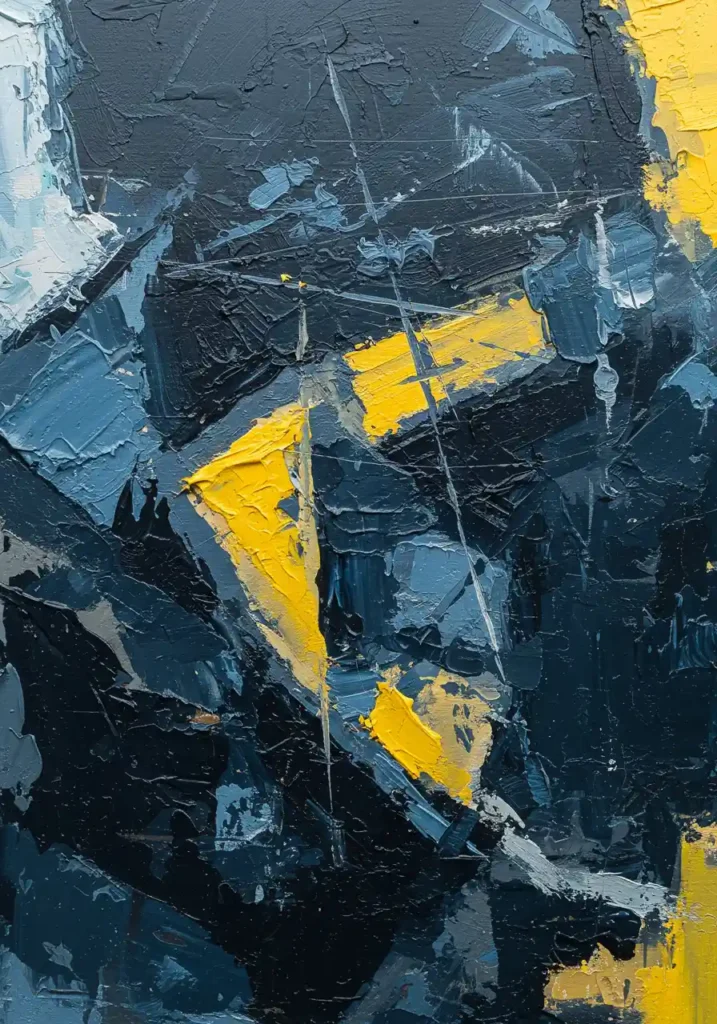
Abstract art offers a unique avenue for artists to express emotion and movement through color and texture. One captivating technique is the use of a palette knife to create heavily impastoed surfaces. This method results in a tactile, sculptural quality that invites viewers to explore the depth and layers of the artwork.
A striking example of this technique is an abstract painting dominated by deep, moody blues—from near-black and indigo to muted steel tones. These shades form the backdrop of the composition, offering a sense of mystery and depth. Against this somber canvas, vibrant yellow shards burst forth, creating dynamic focal points. The contrast between the dark blues and bright yellows is both powerful and eye-catching.
The artist further enhances the piece with touches of white and light grey, particularly in the upper left corner. These lighter hues are applied as broad strokes and fine sgraffito lines, adding texture and complexity. The energetic strokes and visible ridges from the palette knife convey raw energy and movement, making the composition dynamic and fragmented.
This approach to abstract art not only showcases the artist’s skill but also invites viewers into a world of color, texture, and emotion.
11 Artistic Ideas for Dynamic Abstract Drawings
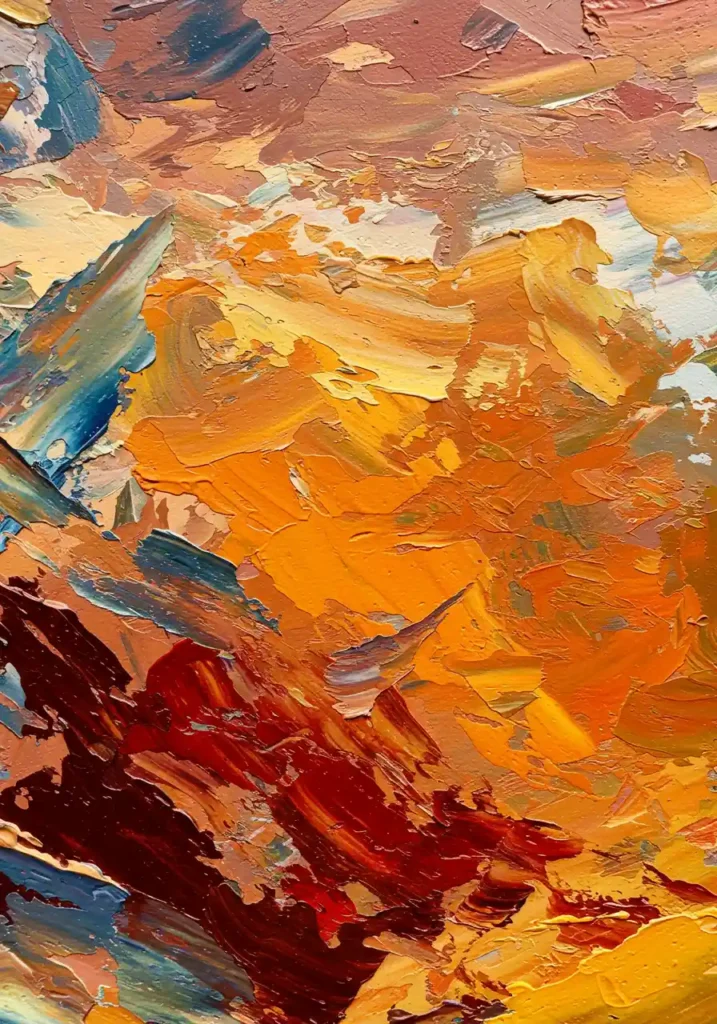
Abstract art offers endless possibilities for expression, and one way to elevate your drawing is by exploring textured and dynamic compositions inspired by painting techniques. While this example focuses on a vibrant abstract painting, you can adapt these ideas to drawing using tools like pastels, crayons, or textured pencils.
Start with a bold color palette. For a warm, energetic feel, use fiery oranges, golden yellows, and deep reds. Contrast these with cooler tones like teal, cerulean, or earthy browns to create depth and balance. Layering is key—experiment with overlapping vibrant and muted shades to mimic the interplay of light and shadow.
Focus on movement and texture. Use sweeping, choppy strokes or crosshatching to convey energy and emotion. Incorporate diagonal lines to create a sense of dynamism and flow. Even in drawing, you can emphasize texture by layering heavily or blending unevenly to add a tactile quality.
Finally, add highlights sparingly with white or cream tones to accentuate depth and draw attention to focal points. By combining bold color contrasts, dynamic strokes, and layered textures, your abstract drawings can evoke the same powerful emotions as a richly textured painting. Let your creativity flow!
12 Captivating Impasto Portraits: Exploring Texture and Color
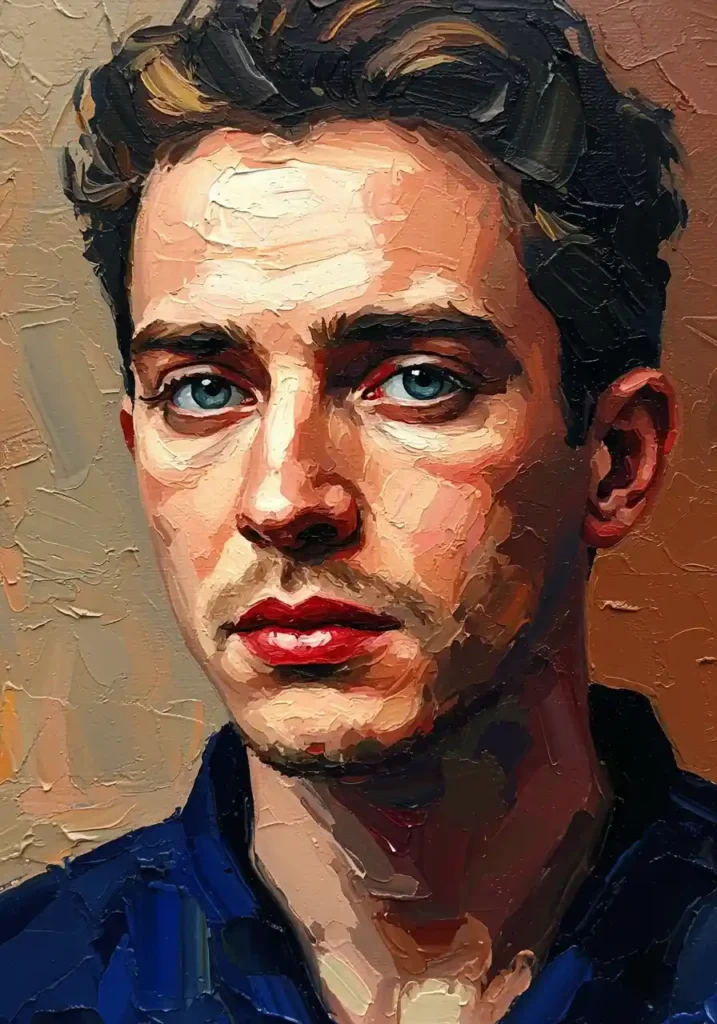
In the world of art, impasto oil painting offers a unique and expressive avenue for artists to explore texture and color. One striking example is a close-up portrait of a young man, where the artist uses a palette knife to create a highly textured, faceted surface. The face is a symphony of colors, with creamy whites and pale peaches highlighting the forehead and cheekbones, while warmer tones define the mid-sections, and deeper hues sculpt the shadows.
The eyes of the subject are particularly mesmerizing, painted in piercing blue with well-defined darker outlines, adding intensity to his gaze. His lips, full and rich in reds and crimsons, exhibit a glossy impasto texture that adds to the portrait’s allure. The tousled dark hair is depicted with directional strokes, capturing both volume and light.
The background, in muted beiges and greys, serves to accentuate the vividness of the subject. The lighting, strategically placed, enhances the dimensionality of the portrait, giving it a modern and tactile feel. This artwork exemplifies how impasto technique can transform a simple portrait into an engaging visual experience.
13 Artistic Ideas for Drawing: A Vibrant Landscape
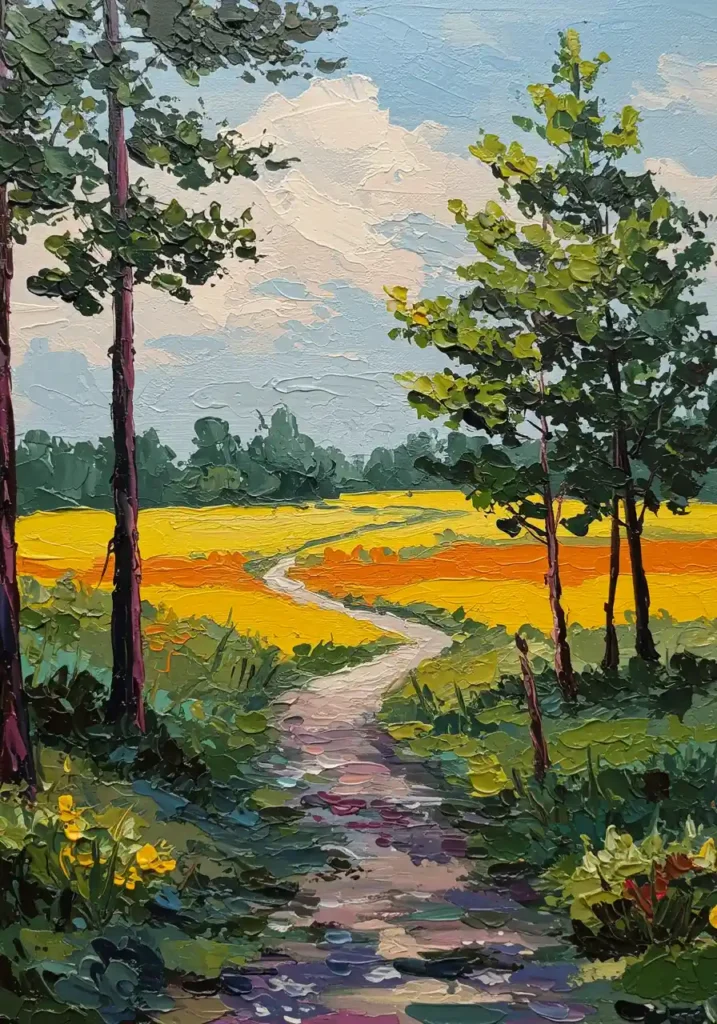
When it comes to artistic inspiration, few things rival the beauty of a vibrant landscape. One idea to explore is creating a textured countryside scene using a heavy impasto technique with a palette knife. This method adds a sculptural, dynamic quality to your work, bringing the scenery to life.
Imagine a sunlit path winding through a field bursting with color. In the foreground, textured strokes in greys, beiges, pinks, and lavenders suggest dappled sunlight on the path, bordered by lush greenery and wildflowers. Adding small yellow blossoms on one side and hints of red and white flowers on the other enhances the natural vibrancy.
The middle ground can feature a field of bright yellows and oranges—perhaps sunflowers or rapeseed—contrasting beautifully with a distant treeline of deep green. Flank the scene with slender trees, their reddish-brown trunks and textured foliage catching the sunlight.
Above, a cerulean blue sky with fluffy white clouds rendered in thick strokes completes the idyllic summer day. This approach not only captures the vitality of nature but also allows you to experiment with bold colors, textures, and light.
Let your creativity flow and bring this cheerful landscape to life in your own style!
14 Artistic Ideas for Dynamic and Textured Drawings
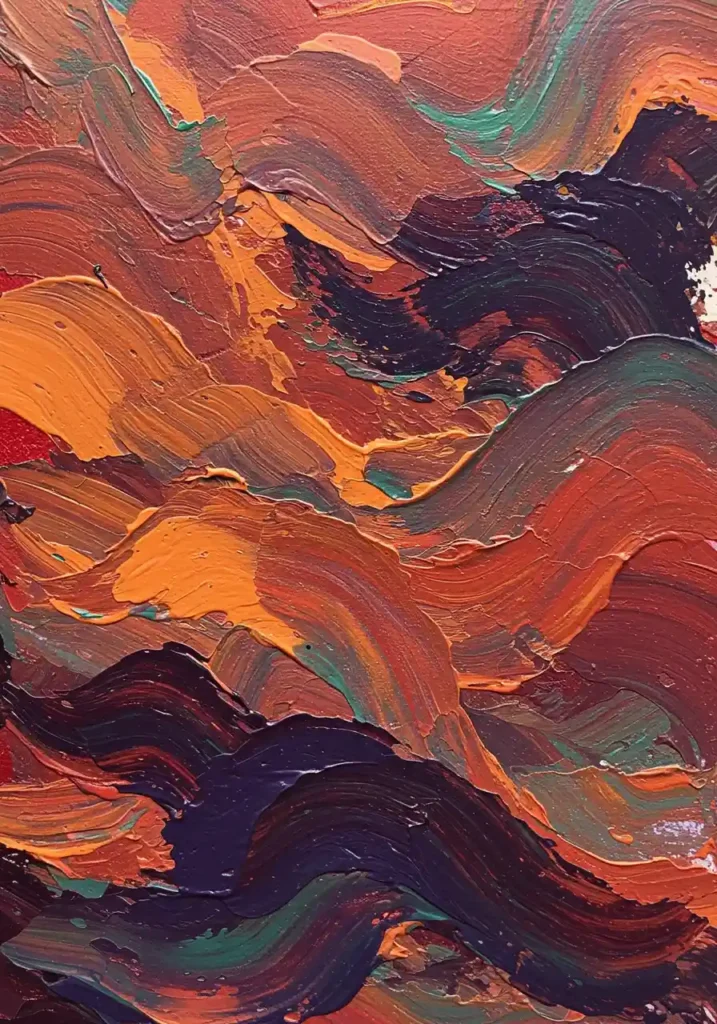
When it comes to artistic inspiration, abstract paintings can offer endless possibilities for your next drawing project. One particularly captivating idea is to explore dynamic textures and movements inspired by heavy impasto techniques, often created with a palette knife.
Imagine crafting a composition that mimics the sweeping waves and undulating forms of an abstract painting. Use bold, energetic strokes to bring life and motion to your drawing. Focus on a rich color palette that evokes warmth and vibrancy: think vibrant oranges, earthy terracotta reds, deep purples, and striking teal accents. These hues can interact beautifully, creating depth and contrast in your work.
To mimic the tactile quality of thick paint, experiment with layering techniques in your medium of choice. For example, use cross-hatching, stippling, or blending to replicate the ridges and grooves of impasto textures. Consider adding small highlights of white or light tones to emphasize depth and movement.
The final result should celebrate the interplay of color and form, inviting viewers to explore the energy and emotion within your piece. Let your creativity flow like the dynamic strokes of an abstract masterpiece!
15 Artistic Ideas for Drawing: Exploring Vibrant Abstracts
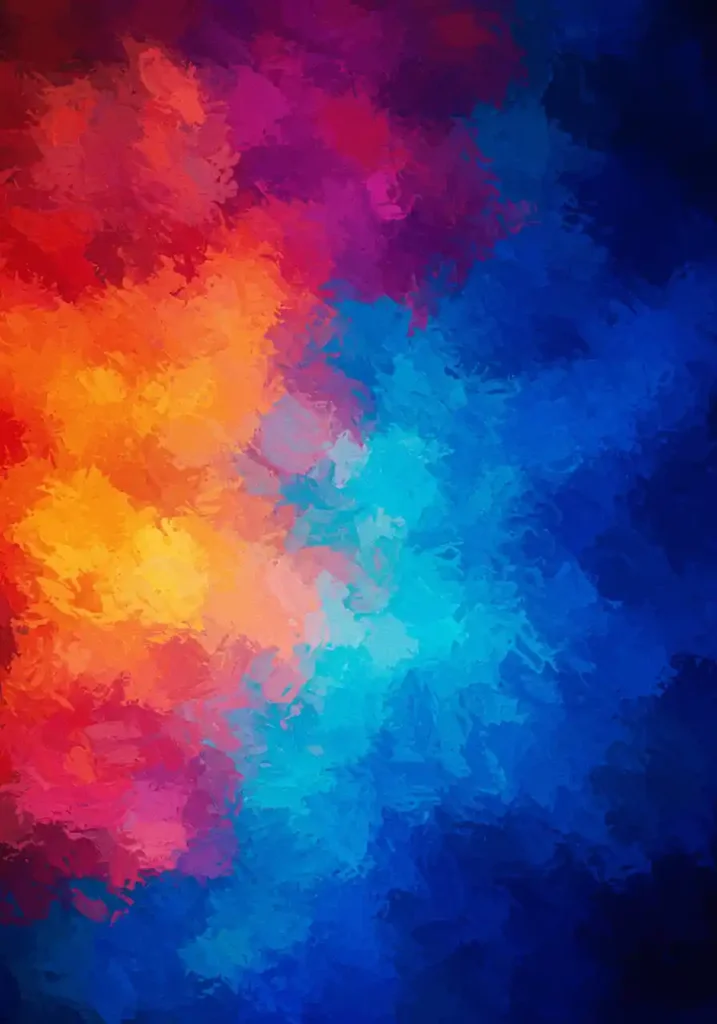
Abstract art offers endless opportunities to experiment with colors, textures, and techniques to create dynamic, visually captivating pieces. One inspiring idea is to play with contrasting color zones and energetic brushstrokes to evoke emotion and movement.
Imagine dividing your canvas into two contrasting zones: a warm area bursting with fiery reds, oranges, and yellows, and a cool section dominated by calming blues. Use acrylics or oils on a textured canvas to enhance the tactile quality of your work. Apply short, choppy brushstrokes with a palette knife or dry brush technique to add depth and energy.
In the warm zone, let yellows radiate from the center, blending outward into oranges and intense reds. Add hints of magenta for a vibrant transition. On the cooler side, layer turquoise and cerulean blues that deepen into ultramarine and navy tones. Allow the colors to intermingle at the boundaries, creating an exciting interplay of hues.
This approach not only emphasizes the contrast between warm and cool tones but also invites viewers to explore the dynamic movement within the composition. The result? A bold, textured masterpiece that celebrates the power of color and creativity. Let your imagination guide you as you bring your abstract vision to life!
16 Artistic Ideas for Drawing: Exploring Textured Mixed-Media Art
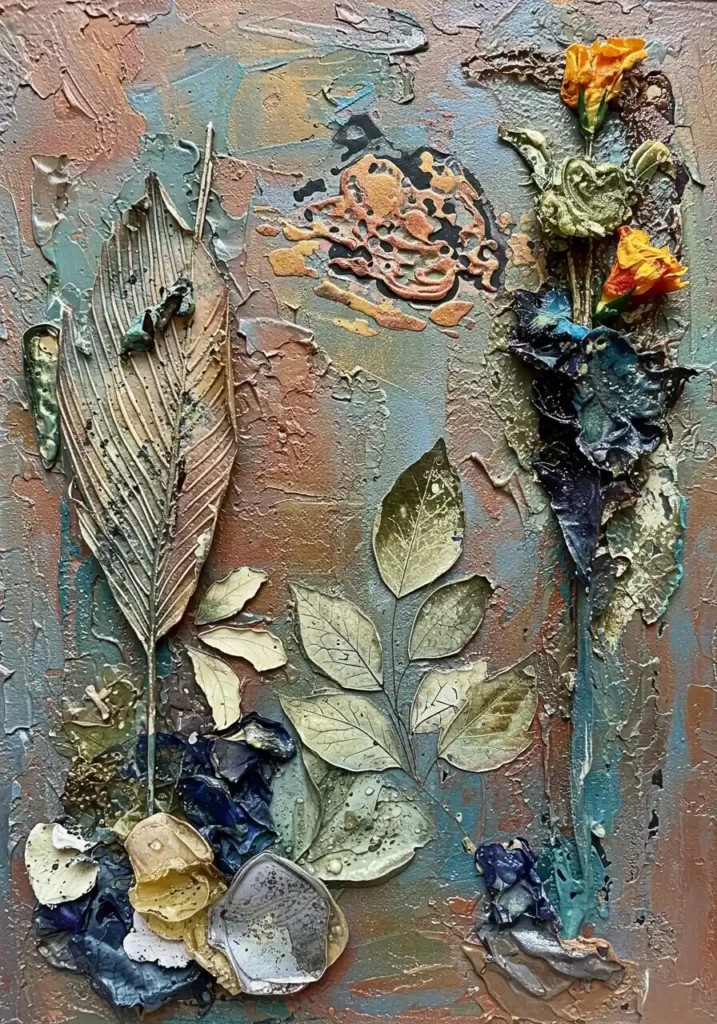
Artistic expression often transcends the boundaries of traditional mediums, and mixed-media creations are a perfect example of this. One inspiring idea for your next drawing project is to incorporate textured elements that blend natural and artificial materials, creating a multi-dimensional masterpiece.
Imagine a heavily textured background with thick, impasto strokes in earthy tones—terracotta, sienna, muted blues, and hints of ochre. Using a palette knife can add depth and movement to your base. Layering metallic accents like gold or copper over darker shades creates a striking contrast.
To elevate your artwork, embed botanical elements. A dried, feather-like leaf with visible veins can serve as a focal point, while smaller branches with pale green leaves add delicate details. Bright pops of color, like orange marigold-like flowers, can emerge from sculpted paint masses for an eye-catching effect.
Scatter additional textures across your piece—crinkled materials, dimensional paint dabs, or metallic-like shards resembling shells—for an organic yet abstract feel. The result is a tactile, earthy composition that beautifully balances muted tones with vibrant highlights.
Experimenting with mixed media allows you to push creative boundaries and craft artwork that feels alive with texture and color.
